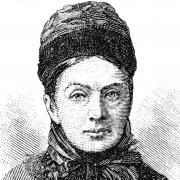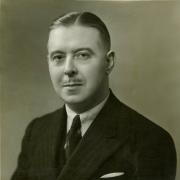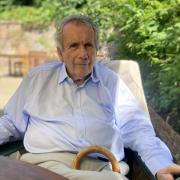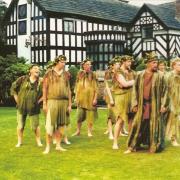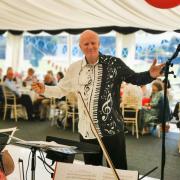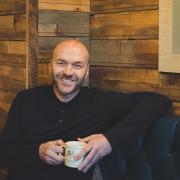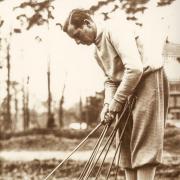Light the candles, throw another log on the fire and listen to the wind howling outside. Here are two purveyors of the genre to tell their own stories. Are you sitting comfortably? Then they’ll begin

FASCINATED BY TRUE CRIME?
CHYAZ SAMUEL
Things Are About To Get Weird podcast
I remember the hushed conversation as if it were yesterday. 'You’re into true crime stories too?' a friend whispered to me, her eyes widening as she realised she wasn’t the only one on our university course who’d pick an evening in with a serial killer documentary over a night out clubbing. It shouldn’t have been too surprising; after all, we were studying broadcast journalism, and had just sat in a seminar on court reporting. But even then, in 2009, the idea of being enthralled by true crime did feel somewhat taboo. Never mind it was the psychology and criminology elements that drew me in. By many, it was simply deemed morbid. How times were to change.
While up to a few years ago there was but a modest handful of true crime television specials to devour, today there are updates by the hour. In addition to traditional media channels, every streaming service, social media platform and audio provider is flooded with new true crime content that truly runs the gamut from tales of murder and mayhem, to exposés of scam artists and wide-scale wrongdoings. And, nestled among the creators of said content, is me. From my home in Cheshire, I produce and host the podcast Things Are About To Get Weird, and since I released the first episodes back in September 2022 the response has been astonishing. Within the first week of launch, my podcast debuted on both the Spotify UK and Apple Podcasts Charts and is currently ranked in the top three per cent of podcasts globally. When I set out to create a show dedicated to strange-but-true tales, I anticipated reality crime would be a key sub-genre for the show – what I hadn’t realised is it would percolate through almost every story I cover. Even when researching an unexplained phenomenon or paranormal incident for an episode, I often discover integral details rooted firmly in true crime territory. So what is it about this subject that is so utterly enthralling, and where has our sudden, insatiable appetite for it come from?
My view on the latter question is that our collective interest in true crime isn’t new at all. It’s just that rather than hearing accounts of criminal scandals delivered via the murder ballads of the Middle Ages or the street literature distributed following the invention of the printing press, we can now glean information about virtually every recorded crime in history instantly via our phones. As this new level of accessibility grew, I noticed that secretive shroud slipping away, leaving us true crime enthusiasts far more free to reveal our interest without fearing a raised-eyebrow reaction, which leads us back to the first question around why this interest exists in the first place. At the heart of it, I believe true crime centres around the most intriguing topic of all: human nature. We’re captivated by real crimes for the same reasons millions of us tune in to follow each twist and turn in the latest television detective dramas. Peering into these stories, whether real or imagined, allows us the opportunity to observe and analyse situations we would hope to never encounter first-hand, but from a safe distance. Humans are naturally curious and we have the ability to be incredibly intrigued by something while simultaneously never wishing to be directly involved with it.
Have there been any downsides to the true crime boom? Certainly. When I launched my podcast, I ensured from the start that accuracy was at the core of everything I produced, and that I approached each case with the care and compassion it deserved. I try to never lose sight of the fact I am discussing real people, and I don’t focus on grim details any longer than absolutely necessary. But there have been criticisms of the wider true crime genre, with concerns being raised that the revolving door of available media is causing audiences to become desensitised. Or, in the case of podcasters and YouTubers, flippant, as they become detached from the realities of the cases they’re continually discussing. I think these comments are valid and should help to shape the personal codes of ethics content producers hold themselves to. But I also think there is genuinely valuable work being done within the true crime genre too. Just take the recent example of The Trial of Lucy Letby podcast. Its coverage of the active criminal trial of the former Countess of Chester Hospital neo-natal nurse was ground-breaking and allowed the public easier access to the most fundamental principle within our legal system: open justice. The concept of justice not only being done, but being seen to be done – or in this case, heard.
So, as we settle in for a few more months of cold, dark evenings, do you find yourself tempted to indulge your curiosity and tune in to a true crime podcast? Whether you listen while cooking, cleaning or commuting, a gripping new soundtrack to your day could be just a click away…
LISTEN IN
A taste of Things Are About To Get Weird podcast
Episode 1: Ursula and Sabina Eriksson
Those living in Cheshire back in 2008 may well remember this astonishing story, which began close to our county’s border on a section of the M6 near Keele Services. In the very first episode of the podcast, I explored the tale of identical twins Ursula and Sabina Eriksson, who caused havoc on the motorway after appearing to be suffering from the rare condition Folie à Deux, or shared psychosis. But what you may not know about are the tragic events that took place next, and how many opportunities were missed to prevent them…
Episode 32: The Phantom Serial Killer of Heilbronn
Between 1993 and 2009, the hunt was on for the elusive criminal dubbed Germany’s most dangerous woman – the female serial killer known as The Woman Without a Face, and later as The Phantom of Heilbronn. This story has one of the most bizarre twists ever found in our episodes. If you are fascinated by murder mystery sagas, this could be the ideal starting point for you as a new listener of Things Are About To Get Weird.
Episode 36: The Radium Girls
In factories across the United States in the early 20th century, young women were being employed to use an exciting new glow-in-the-dark paint to decorate clock and watch faces. But little did they know that one of the paint’s key ingredients, radium, was one of the most dangerous substances a human could ingest. In this episode, I detail the shocking case of the group of ladies who came to be known as The Radium Girls, and how they fought to change the working world under the most unthinkable of circumstances.
Chyaz Samuel is a freelance presenter and writer from Sandbach with a large social media presence, especially on her TikTok channel where she has 182,000 followers. She publishes a new episode of her podcast Things Are About To Get Weird, every other Wednesday. The show is free to listen to and available on all podcast players with each instalment focusing on a different strange-but-true tale

THE KILLING FROZEN IN TIME
Colin Evans
Author
NO PITY: The cold-blooded murder which gripped Edwardian Britain – an investigation
Knutsford has long been famous for its history, literary associations and picturesque setting in the Cheshire countryside but, at the start of the Edwardian era, tourists flooded into the town not to wander along the architectural timeline of King Street, or to visit the last resting place of the Victorian author Elizabeth Gaskell, but to view the scene of a bizarre murder.
It occurred on Easter Sunday evening 1901, just after the church bells had stopped ringing for evensong, when the bullet-riddled body of a journeyman tailor was found on the verge of Mere Heath Lane, not far from the town centre. John Bould had been shot five times from point-blank range. As the police launched a manhunt for an armed killer, another sensational issue emerged – the chief witness, a 30-year-old domestic servant, claimed that seconds before the shooting, and only a few hundred yards further along the lane, she had been assaulted by a well-known businessman. A sex scandal.
For the next few weeks, Knutsford was inundated with murder mystery tourists. The Cheshire Lines railway company laid on specials as hundreds poured into the town from all over the North West and long queues formed outside the Sessions House for the early judicial proceedings.
Reported in colourful style in newspapers the length and breadth of the country, the story enthralled Britain throughout that summer. But the prisoner, James Parrott whose family ran a draper's shop in King Street, Knutsford, was found not guilty by a jury at Chester Assizes and with no other suspect, the police put the case into cold storage where it remained frozen until I started investigating and published my book, No Pity.
I was born and bred in Knutsford and, as a reporter, I covered a number of murder cases but it wasn't until 2021 that, by chance, I first came across the story of the 190l murder. I was intrigued and I was surprised to learn the shooting took place only half a mile from the home of the little girl who became my grandmother and that the gunman rushed past her house as he made his escape.
I spent two years researching and writing the book and found that Knutsford, in the first year of the 20th century, was a fascinating town of contrasts, highlighted by the events of that spring and summer.
Britain was in a deeply patriotic mood. Queen Victoria had died and Edward VII was the new monarch. Several local men had fought in the Boer War in South Africa as volunteers, and when they returned, on the day before the annual Royal May Day festival, huge crowds and a band welcomed them home. Nowhere did the flag of St George fly higher. But there was a dark side. Knutsford had become the hanging capital of Cheshire, taking over from Chester the responsibility of executing murderers, and one of the inmates at the huge prison behind the Sessions House was young James Parrott, charged with gunning down John Bould. Parrott knew that if convicted he would be hanged only a few hundred yards from where he was born in King Street, and right opposite St John's Church where he was baptised – a short, straight line from birth to ignominious death. As it happened, Parrott was acquitted at his trial and lived the rest of his life in relative obscurity.
It was not only geographical proximity that featured in my investigation. I was surprised at the connections between individuals and families involved in the case. For example, one of the most significant prosecution witnesses was an 11-year-old girl whose father was a lawyer's clerk working for the defence team. He, in turn, became a leading Freemason and when he retired from his role was replaced by the sergeant who had led the murder investigation. Perhaps I should not have been surprised, Knutsford was an important town, but a small one.
John Bould was buried in the graveyard of St John's Church. He was a little-known tailor who had lodged with a family in Swinton Square, but his funeral was a grand affair. Workmates carried the coffin from his home to the church. Townsfolk lined the way and the service was attended by representatives of many local organisations including the urban district council. There is no headstone and it is difficult to locate the exact location of the grave, but – another coincidence – it lies close to those of James Parrott's family, his mother who gave evidence at his trial, his father, and his grandfather.
Colin Evans was a crime and sports journalist from 1964-2006, working on the Knutsford Guardian and the Manchester Evening News. He now lives in Scotland.
NO PITY: The cold-blooded murder which gripped Edwardian Britain – an investigation, is available on Amazon. While the main theme of the book is the murder and the subsequent court proceedings, it also examines life in Knutsford at the onset of the Edwardian era.






